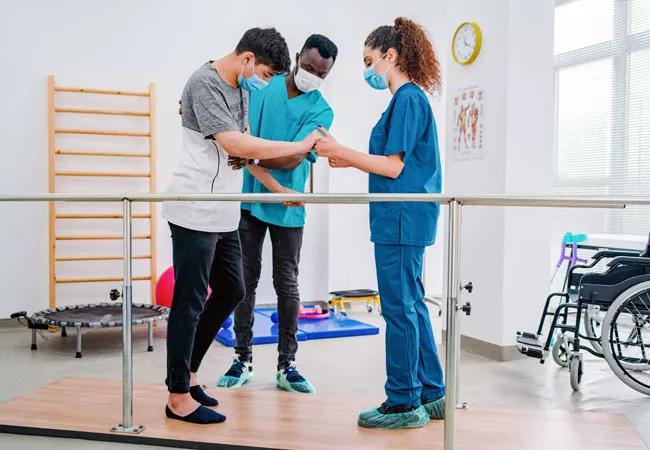How ‘Let’s Get Moving!’ is improving physical activity in children undergoing cancer treatment

By Neha Patel, MD; Julie Nowicki PT, DPT; Nikki Agarwal, MD; Ann Marie Schroeder-Pace PT, MPT; and Marisa Pavia MA, CCC-SLP
Advertisement
Cleveland Clinic is a non-profit academic medical center. Advertising on our site helps support our mission. We do not endorse non-Cleveland Clinic products or services. Policy
A cancer diagnosis is a life-altering experience for patients and their families. The incidence rate of childhood cancers has been increasing over the last decade. Fortunately, with improved cancer-directed treatments, more children are surviving their cancer. In recent years, it has become increasingly evident that childhood cancer survivors suffer from limitations in their physical performance due to low muscle strength, decreased flexibility and reduced cardiorespiratory endurance. Systematic review of literature has shown that children with cancer have reduced mobility during and after treatment, and early interventions in physical training can reduce some of these long-term impacts on physical performance.
There are several reasons identified in the literature why patients with childhood cancer develop deconditioning, physical disabilities, reduced mobility and decreased flexibility during and after treatment. Cancer and cancer-directed treatments can lead to increased fatigue, pain, poor appetite, emotional stress, anxiety, depression and lack of motivation. Furthermore, cancer therapies can have direct damage to the bones, nerves and muscles leading to decreased bone mineralization, neuropathy and muscle weakness. Cancer patients become dependent on their caregivers for taking them to their appointments and in other aspects of their care. Thus, children and adolescents with cancer have limited opportunities to remain mobile and to perform frequent physical activity and strengthening.
Advertisement
Distance of rehabilitation services from their oncology care clinics and residence can also impact adherence to physical and occupational therapy programs. In our cross sectional review of patients receiving active cancer therapy, we found that 75% of our patients experienced physical impairments from either their cancer or cancer-related surgical and medical treatments. “Let’s Get Moving!” is the mobility program developed to preserve, improve and maintain the functional and mobility capacity of our cancer patients.
We assembled an interdisciplinary team of administrative leaders, rehabilitation therapists, clinic nursing coordinators, clinic managers and clinical providers to build this program from the ground up. Development of this program required a designated space for rehabilitation assessments and interventions, financial support, creation of appointment slots, strategizing patient workflows during appointments, creation of specific rehabilitation assessments tools and provision of physical therapy services. These services were integrated with the clinic and infusion appointments of our cancer patients.
By providing the program within the areas of their cancer treatment, these services are easily accessible and convenient for all our patients. This also ensures that all patients in our cancer care are assessed by our physical therapist. The main goals of the mobility program are to identify, intervene, educate and prevent deconditioning for our cancer patients early in their cancer journey in order to prevent short-term and long-term disabilities in their physical performance. We also want to ensure continued and progressive improvement in our patients’ mobility, flexibility, strength and endurance. Partnership between the medical team and the rehabilitation service specialist allows us to develop and monitor individualized rehabilitation programs for our patients geared towards the current and anticipated mobility impairments from the cancer or cancer-related treatments.
Advertisement
Our overall mission is to maintain our patients’ independence and their ability to participate in activities at home, school and in community settings during and following cancer therapy.
We launched “Let’s Get Moving” mobility program in February 2021 using our departmental funds. We have dedicated physical therapists and a consult room assigned to perform patients’ functional, strength, cardiorespiratory endurance and flexibility assessments. Based on these assessments, our therapist: a) formulates instructions for a home exercise program b) arranges appropriate physical therapy, occupational therapy and orthotics referrals and c) continues delivering additional physical therapy sessions while they are in the clinic for their medical care. The therapist also provides an instructional manual demonstrating the exercises to educate patients and their caregivers as well as tools to take home to help with strengthening and mobility.
During their subsequent clinic appointments, our patients undergo periodic assessments from our physical therapist to ensure: a) continued progress in their strength, mobility and flexibility b) adherence to the physical therapy and home exercises and c) modifications to the exercise and rehabilitation therapies, if needed. By partnering with caregivers, patients, community therapists and the medical team, we are able to develop an exercise and mobility program that is geared towards patients’ current and projected physical and mobility impairments consequent from their cancer treatments.
Advertisement
We have been enrolling all our patients into this program. On review of our outcome data, we found that the mobility program improved our patients’ activity level and increased participation in physical therapy sessions. This program helped us identify barriers in providing such a crucial aspect of care to our children and assisted in devising an effective plan to overcome these barriers.
Through this program, we identified the physical disabilities among patients with childhood cancers during their active cancer-related therapy chemotherapy and provided them with easy and affordable access to physical therapy services. We are hopeful that future assessments will demonstrate that these patients can regain their baseline functions with continued therapy interventions.
About the authors
Dr. Patel is a pediatric hematologist-oncologist at Cleveland Clinic Children’s; Dr. Agarwal is a fellow in the Department of Pediatric Hematology/Oncology & Blood and Marrow Transplantation (BMT) at Cleveland Clinic Children’s; Ms. Nowicki is a physical therapist at Cleveland Clinic Children’s Hospital for Rehabilitation (CCCHR); Ms. Pavia is a program manager at CCCHR; Ms. Schroeder-Pace is a physical therapist and program manager of evidence-based practice and outcomes at CCCHR.
Advertisement
Advertisement

Key themes and insights into the family-caregiver experience

First-of-its-kind clinic for immune-related adverse events supports oncologists in managing severe side effects

Early communication between oncologists and ophthalmologist warranted

Variables affect nuances of the conversation

Driving advances in cancer care

Challenges emerge with application of interim PET scans

Complex, bidirectional interactions exist between cancer, therapy, toxicities and eating behaviors

Helping patients with cancer struggling with depression, anxiety and other mental health issues